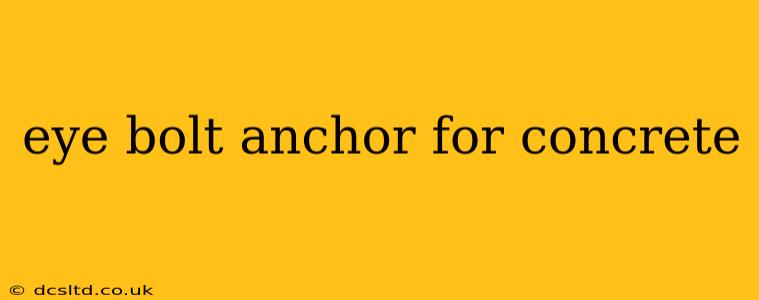Eye bolts are incredibly versatile fasteners, finding applications in numerous construction and industrial settings. When securing them in concrete, however, proper anchoring is crucial for safety and structural integrity. This guide will delve into the specifics of using eye bolt anchors in concrete, addressing common questions and concerns.
What are the different types of eye bolt anchors for concrete?
Several types of anchors are suitable for securing eye bolts in concrete, each with its own strengths and weaknesses:
-
Drop-in anchors: These anchors are simple to install and require only a hammer drill. They are suitable for lighter loads and are often made of materials like zinc-plated steel or stainless steel.
-
Sleeve anchors: These anchors consist of a sleeve and a screw. The sleeve is inserted into the pre-drilled hole, and the screw expands the sleeve against the concrete walls. Sleeve anchors are more robust and can handle heavier loads than drop-in anchors. They are typically made from high-grade steel.
-
Chemical anchors: These anchors utilize a resin or epoxy that fills the drilled hole, providing excellent bonding with the concrete. Chemical anchors are ideal for heavy-duty applications and offer superior load-bearing capacity. They are often preferred when high strength and reliability are critical.
-
Expansion anchors: These anchors use an expanding mechanism to create a tight fit within the concrete. They are available in various sizes and materials, making them versatile for different load requirements.
How do you choose the right eye bolt anchor for concrete?
Selecting the right eye bolt anchor hinges on several factors:
-
Load capacity: The weight the anchor needs to support directly influences the type and size of anchor required. Always consult the manufacturer's specifications to ensure the anchor can handle the intended load.
-
Concrete type: The strength and composition of the concrete affect anchor performance. Harder concrete generally allows for greater holding power.
-
Base material: The material the eye bolt is made from is also a factor. Stainless steel, for example, offers greater corrosion resistance than zinc-plated steel.
-
Installation method: Consider the ease of installation, the available tools, and the skillset of the installer.
What is the best eye bolt anchor for heavy loads in concrete?
For heavy loads, chemical anchors or high-capacity expansion anchors are generally the best choices. These anchors provide superior holding power and are designed to withstand significant stress. Always ensure the anchor's rated load capacity exceeds the anticipated load by a significant safety margin.
How much weight can an eye bolt anchor hold in concrete?
The weight an eye bolt anchor can hold depends entirely on the type of anchor, its size, the concrete's quality, and the installation method. Never rely on estimations. Always consult the manufacturer's data sheet for the specific anchor you're using. This data sheet will provide the safe working load limit (SWL) under various conditions.
What size hole do I need to drill for an eye bolt anchor in concrete?
The required hole size varies depending on the specific type and size of the anchor. The manufacturer's instructions will always specify the correct drill bit size to use. Using the wrong size drill bit can compromise the anchor's performance and safety.
How do you install an eye bolt anchor in concrete?
The installation process differs slightly depending on the type of anchor. However, general steps include:
-
Drilling: Drill a hole of the correct size and depth according to the anchor's specifications.
-
Cleaning: Clean the drilled hole of dust and debris using a brush or compressed air. This ensures proper adhesion for chemical anchors.
-
Anchor placement: Insert the anchor into the hole. For expansion anchors, carefully expand the anchor within the hole. For chemical anchors, inject the resin according to the manufacturer's instructions.
-
Curing: Allow chemical anchors sufficient curing time before applying any load.
-
Eye bolt installation: Secure the eye bolt into the anchor.
Always refer to the specific instructions provided by the anchor's manufacturer for detailed installation procedures.
Conclusion
Selecting and installing the correct eye bolt anchor for concrete is crucial for safety and structural integrity. Careful consideration of the load, concrete type, and anchor type, along with adherence to manufacturer's instructions, are vital for a successful and safe installation. Remember, when dealing with significant loads, consulting a qualified structural engineer is always recommended.
